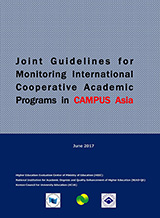Publication: Joint Guidelines for Monitoring International Cooperative Academic Programs in CAMPUS Asia
In June 2017, ‘‘Joint Guidelines for Monitoring International Cooperative Academic Programs in CAMPUS Asia’’ were produced by three quality assurance (QA) agencies, i.e., the Higher Education Evaluation Center of the Ministry of Education (HEEC) in China, the National Institution for Academic Degrees and Quality Enhancement of Higher Education (NIAD-QE) in Japan, and the Korean Council for University Education (KCUE) in Korea.
The Collective Action for Mobility Program of University Students in Asia (CAMPUS Asia) is a government-led initiative to promote high quality international cooperative academic programs among the universities in China, Japan, and Korea. Under this initiative, 10 programs were selected as pilot programs in 2011 and were funded by the three governments for five years. Following the successful outcome of the pilot programs, 17 programs—nine new programs and eight ongoing programs—were selected as full-fledged programs in the fall of 2016. These programs are also to be funded by the three governments for five years.
To support CAMPUS Asia through QA, the three QA agencies conducted monitoring on the CAMPUS Asia programs (first and second monitoring in 2013 and 2015, respectively) during the pilot program period. The main purpose of the monitoring was to identify good practices from the viewpoint of educational quality and to widely disseminate them throughout the higher education community rather than merely confirming that the programs have a minimum level of quality.
The second monitoring on the CAMPUS Asia programs in 2015 was conducted jointly with a high level of cooperation among the three QA agencies, by using a common QA framework. The framework was established based on the results of a comparative analysis of the monitoring criteria and procedures used in the first monitoring, which was operated independently by the three countries under their respective regulations for QA.
The guidelines were produced based on the experience of the joint monitoring. The contents of the guidelines include general principles, an implementation system, procedures, criteria and viewpoints, and considerations when conducting monitoring.
The guidelines not only enable the three QA agencies and reviewers to clearly understand the method of CAMPUS Asia monitoring, but would also serve as a good reference for other QA agencies when conducting monitoring or evaluation of international cooperative academic programs, especially when working with partner agencies in other countries, and for Higher Education Institutions in their internal quality assurance work.
The guidelines is available here (PDF, 6.7MB, English).
See this site for an overview of CAMPUS Asia monitoring.


